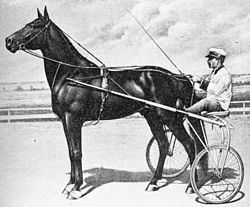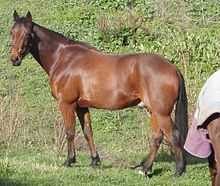Standardbred
 The Standardbred is best known as a harness racing breed. | |
| Distinguishing features | Well-muscled, long body, slightly heavier than a Thoroughbred, solid legs and powerful shoulders and hindquarters Able to trot or pace at speed for racing. |
|---|---|
| Alternative names |
Trotter Pacer |
| Country of origin | USA |
| Horse (Equus ferus caballus) | |
Standardbreds are a breed of horse best known for their ability to race in harness at a trot or pace instead of under saddle at a gallop. Developed in North America, the breed is now recognized worldwide for its harness racing ability. They are solid, well-built horses with good dispositions that are also used under saddle for a variety of equestrian activities, particularly in the Midwest, Eastern United States and Southern Ontario.
Breed history


In the 17th century, the first trotting races were held in the Americas, usually in fields on horses under saddle. However, by the mid-18th century, trotting races were held on official courses, with the horses in harness. Breeds that have contributed foundation stock to the Standardbred breed included the Narragansett Pacer, Canadian Pacer, Thoroughbred, Norfolk Trotter, Hackney, and Morgan. Breeders selected bloodlines that would produce the fastest horses, with one of the most notable sires being the gray Thoroughbred stallion Messenger, which was exported to the United States in 1788. Messenger was bred to race on flat, but like many of the early Thoroughbreds, had Norfolk Roadster blood in his pedigree. He was mated to many Thoroughbred mares, and was soon found to have the ability to produce good trotting horses. Messenger's descendant, the legendary Hambletonian 10, also known as Rysdyk's Hambletonian, was born in 1849. He was sold, his owners thinking he was worthless, but later became one of the most prolific sires of Standardbreds, today with nearly every trotter or pacer tracing its lineage back to him. He had sired 1,335 offspring between 1851 and 1875. Another influential sire was the Thoroughbred Diomed, born in 1777. When the sport started to gain popularity, more selective breeding was done to produce the faster harness trotter.
The name "Standardbred" was first used officially in 1879, because, to be registered, every Standardbred had to be able to trot a mile within the "standard" of two minutes and 30 seconds. Today, many Standardbreds race much faster than this original standard, with several pacing the mile within 1 min, 50 sec, and trotters are only a few seconds slower than pacers. Slightly different bloodlines are found in trotters than in pacers, though both can trace their heritage back to Hambletonian 10.
The Standardbred stud book was formed in United States in 1879 by the National Association of Trotting Horse Breeders.[1]
Breed characteristics

Standardbreds tend to be more muscled and longer bodied than the Thoroughbred. They also are of more placid dispositions, as suits horses whose races involve more strategy and more changes of speed than do Thoroughbred races. Standardbreds are considered people-oriented, easy-to-train horses.
They are generally a bit heavier in build than Thoroughbreds, but have refined, solid legs and powerful shoulders and hindquarters. Standardbreds have a wide range of heights, from 14 to 17 hands, although most are between 15 and 16 hands. Most often, they are bay or the darker variation of bay called "brown", although other colors, such as chestnut and black, are not uncommon. Gray and roan are also found.[2] The tobiano pattern is seen in some New Zealand-bred horses.
The standardbred typically weighs between 408 and 544 kilograms; their heads are refined and straight with broad foreheads, large nostrils, and shallow mouths. The typical Standardbred body is long, with the withers being well defined, with strong shoulders and the muscles being long and heavy, which helps with the long strides. The neck of the standardbred is muscular and should be slightly arched, with a length of medium to long. Their legs are muscular and solid with muscles on the inside and outside of the legs, with generally very tough and durable hooves.
The two basic types are trotters and pacers. As the name suggests, the trotters' preferred racing gait is the trot, where the horses' legs move in diagonal pairs; when the right foreleg moves forward, so does the left hind leg, and vice versa. The pace is a two-beat lateral gait; pacers' forelegs move in unison with the hind legs on the same side.
However, the breed also is able to perform all other horse gaits, including the canter, and pacers can be retrained to trot. This has been found to be due to a single-point mutation in gene DMRT3, which is expressed in the I6 subdivision of spinal cord neurons; this area is responsible for coordinating the locomotor network controlling limb movements. The point mutation causes early termination of the gene by coding for a stop codon, thus altering the function of this transcription factor.[3]
Uses
Standardbreds are known for their skill in harness racing, being the fastest trotting horses in the world. Because of their speed, Standardbreds are often used to upgrade other breeds of harness racers around the world, such as the Orlov Trotter and French Trotter.
In Australia, Canada, New Zealand, the United Kingdom, and the United States, races are held for both trotters and pacers. In continental Europe, all harness races are conducted between trotters.

Major races for North American trotters include the Peter Haughton Memorial for two-year-olds, and the World Trotting Derby, Yonkers Trot, Hambletonian, and Kentucky Futurity for three-year-olds. The Hambletonian is sometimes referred to as the "Kentucky Derby of Harness Racing". The Trotting Triple Crown is made up of the Yonkers Trot, Hambletonian Stakes, and Kentucky Futurity.
Some of the major pacing races in North America include the Woodrow Wilson and Metro Stake for two-year-olds, and the Little Brown Jug, Meadowlands Pace, North America Cup and the Adios Pace for three-year-olds. The Little Brown Jug, the Messenger Stakes, and the Cane Pace comprise the Pacing Triple Crown. Major races in Australia and New Zealand include the New Zealand Trotting Cup, the Miracle Mile and the Inter Dominion series.

In 1968, New Zealand-bred Cardigan Bay became the first Standardbred horse ever to win US$1 million, and the ninth horse to do so worldwide (the first eight were Thoroughbreds). He was popular in the United States, and appeared with Stanley Dancer on The Ed Sullivan Show as the "million dollar horse".[4]
Standardbreds are also used in horse shows and for pleasure riding. They are also popular as light buggy horses for the Amish people, who eschew motorized vehicles. Many retired Standardbreds find a second career off the track with the help of various dedicated organizations, such as the Standardbred Pleasure Horse Organization.
The breed is quite good at jumping, making them suitable for the sport horse disciplines of hunt seat, show jumping, show hunter, and eventing. The breed is also seen in dressage, and their excellent temperaments make them good trail riding and ranch horses. In addition, because of the genetics of the breed, they can also be encouraged and trained to perform smooth ambling gaits, notably the rack and the stepping pace. The number of gaited Standardbreds is steadily growing in the United States, with some stud farms dedicated to breeding individuals with this characteristic. Standardbreds are also gaining popularity in Australia as endurance horses, from the 20 km social rides and 40 km training rides, up to the 80 km endurance rides. They are known for their strong and dense bones, suitable conformation and ability to maintain high trotting speeds for extended periods of time comfortably. Part of the reason for this development is also an attraction to the kindness and manageable temperament of the breed, especially for riders who do not wish to be competitive against the purpose bred Arabian horses that are often more difficult and competitive to ride, and just enjoy completing the distances.
Citations
- ↑ The Stallion Place Retrieved 2010-2-8
- ↑ Lynghaug Official Horse Breed Standards Guide p. 322
- ↑ Andersson, Lisa; Larhammar (29 August 2012). "Mutations in DMRT3 affect locomotion in horses and spinal circuit function in mice". Nature 488 (7413): 642–646.
- ↑ Inter Dominion Championships Retrieved 2010-2-22
4.Encyclopedia of Horses by Debby Sly
References
- Lynghaug, Fran (2009). The Official Horse Breeds Standards Book: The Complete Guide to the Standards of all North American Equine Breed Associations. Minneapolis, MN: Voyageur Press. ISBN 978-0-7603-3499-7.
External links
| Wikimedia Commons has media related to Standardbred horse. |
| ||||||||||||||||||||||||||||
.jpg)